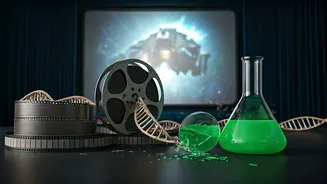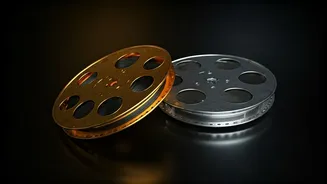Time Travel Follies
Time travel, a staple of science fiction, frequently takes a beating when it comes to real-world science. Films such as 'Back to the Future' are celebrated
for their entertainment value, they often play fast and loose with physics. The concept of paradoxes, the idea that altering the past can unravel the present, is often a source of comedic and dramatic tension, even if it doesn't fully align with current scientific understanding. The complexities of temporal mechanics frequently get streamlined or outright ignored in favor of engaging narratives. The lack of scientific rigor can be entertaining, sparking discussions on theoretical concepts and possibilities. Though these films may not be scientifically accurate, they do often encourage viewers to think about the nature of time, cause and effect, and the potential, or impossibility, of bending the laws of the universe.
Explosions and Physics
Explosions are a guaranteed way to grab an audience's attention in action and sci-fi films, but their depictions are often exaggerated. Sound in space is a frequent offender, since sound waves cannot travel through a vacuum. In reality, vast explosions would likely be silent. Furthermore, the effects of explosions, from the impact of the blast wave to the dispersal of debris, are also typically dramatized. While special effects have improved dramatically over time, the desire for visual spectacle still often overrides scientific accuracy. These cinematic exaggerations serve to heighten the drama, providing an exciting visual experience that may not match the science.
Medical Misrepresentations
Medical dramas and science fiction often rely on scientific concepts, but sometimes struggle to portray them correctly. The speed at which diseases progress, the effectiveness of medical procedures, and the capabilities of the human body can all be simplified or misrepresented for dramatic effect. The portrayal of medical professionals can also fall short, with characters often acting more like superheroes than realistic practitioners. For example, the ability to revive a patient after the heart has stopped is often portrayed in ways that depart from medical practice. Even though the films may have medical themes, the focus remains on narratives that prioritize entertainment and dramatic tension over scientific accuracy.
Space and Astronomy
Space, the final frontier, presents numerous challenges for accurate cinematic representation. The distances between stars and planets, the effects of zero gravity, and the behavior of celestial bodies are frequently simplified. Spacecraft designs, too, often reflect stylistic choices more than engineering realities. For example, scenes depicting the speed of light, or the effects of radiation on the human body are often shown in the films. Moreover, the depiction of alien lifeforms, their appearance, behavior, and abilities, is also often subject to artistic license. In the end, films need to strike a balance between scientific accuracy and the need to tell a good story.
Evolutionary Inaccuracies
The concept of evolution is often simplified, or even completely misunderstood, in films. The pace of evolution is usually drastically accelerated. Characters might adapt to new environments within weeks or even days. Dramatic license frequently overrides the understanding of natural selection, genetic mutation, and the vast time scales required for species to change. Similarly, the depiction of prehistoric creatures often includes scientific inaccuracies. Dinosaurs, for instance, are frequently shown inaccurately, and their behaviors are speculated upon based on limited fossil evidence. These inaccuracies can distort viewers' perceptions and understanding of evolutionary processes. Despite the efforts, filmmakers consistently aim to entertain the audience with exciting and visually appealing depictions of the natural world.
Technology Gone Wrong
The portrayal of technology in movies often takes liberties with the present and future. The functionality and potential of technological devices are frequently exaggerated, particularly in science fiction. This includes how artificial intelligence, robotics, and communication technology work. Holograms and virtual reality environments are also common in film, but often portrayed in unrealistic ways. Devices may perform far beyond their actual capabilities, driven by the need to tell a more compelling story. The integration of technology into daily life or its possible impact on society is often simplified. While technology has advanced to a great degree, there are still many things that are not possible in the real world as shown in films.
Environmental Issues
Environmental themes in films, while sometimes aiming to raise awareness about climate change or other environmental concerns, occasionally miss the mark. The complexity of ecological systems and the delicate balance of nature are often simplified for the sake of a straightforward narrative. Dramatic events, such as global disasters or ecological collapse, may be depicted in a way that does not fully reflect real-world science. Films might present an overly simplistic view of environmental issues or exaggerate the causes and consequences. The focus may be on creating compelling drama, rather than providing an accurate understanding of ecological problems. While raising awareness is still essential, a balanced perspective helps in a complete understanding of the issues.













